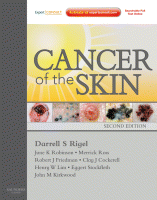Physical Address
304 North Cardinal St.
Dorchester Center, MA 02124

Key Points Several genodermatoses have a predisposition for the development of one or more types of skin cancers. Internal malignancies may also arise in a few. These diseases are caused by mutations in over 30 genes which normally function as…

Key Points Potential risks and benefits associated with phototherapy and drug therapy should be discussed with all patients. Screening examinations should be performed prior to prescribing a therapy with carcinogenic risk. Attention must be paid to treatment interactions that may…

Key Points Spitz nevi can be clinically and histopathologically distinguished from melanoma in a large majority of cases. Spitz nevi are predominantly seen in children and young adults, but recent studies have shown a broader age range than was previously…

Key Points Approximately 10% of melanomas occur in family clusters. In North American populations, mutations in the CDKN2A gene are associated with up to a 76% lifetime risk for melanoma. CDKN2A may also increase the risk for pancreatic cancer to…

Key Points Pregnancy does not have an adverse effect on the prognosis of patients with stage I/II melanoma. There is some evidence that pregnant patients are diagnosed with thicker melanomas compared with non-pregnant controls, but this finding needs further study.…

Key Points Melanoma management should be tailored to the needs of each individual patient. Surgical excision is the cornerstone of melanoma management. Sentinel lymph node biopsy is currently a staging and prognostic tool in the management of melanoma. Adjuvant therapy…

Key Points It is essential that clinicians understand the appropriate methods for biopsy of lesions that are highly suspect for melanoma to enhance accurate diagnosis. Histopathologists who diagnose cutaneous melanoma must be aware of the many different histologic variants and…

Key Points Staging has significant impact on prognostic assessement, treatment decision-making, and clinical trial planning and analysis. Primary tumor (Breslow) thickness and ulceration continue to represent important prognostic factors for survival and define T-category strata in cutaneous melanoma. Mitotic rate,…

Key Points The incidence of melanoma has been increasing faster than that of any other cancer in the United States. Early detection of melanoma is critical for better patient survival. Many early melanomas can be recognized with the help of…

You’re Reading a Preview Become a Clinical Tree membership for Full access and enjoy Unlimited articles Become membership If you are a member. Log in here